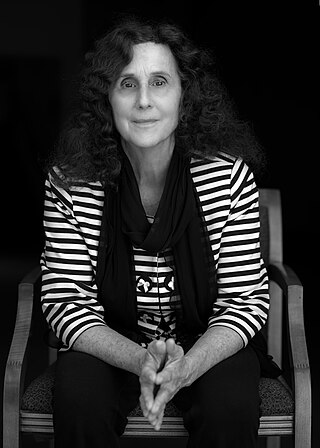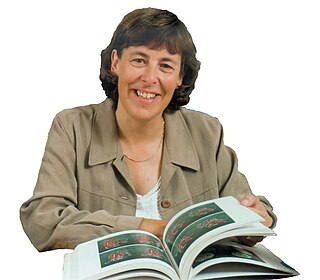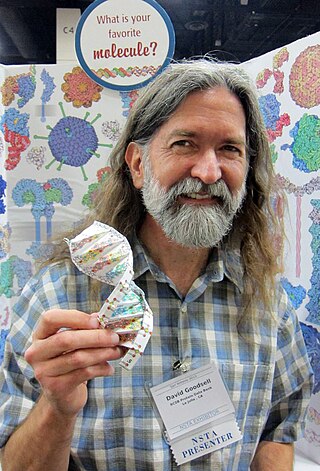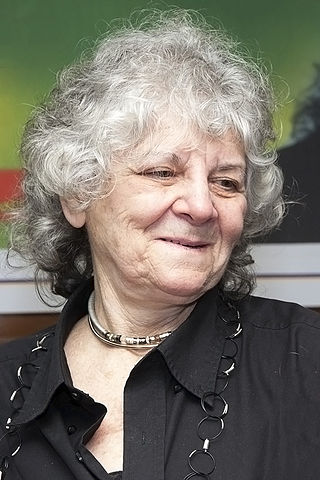
Pamela Jane Bjorkman NAS, AAAS is an American biochemist. She is the David Baltimore Professor of Biology and Biological Engineering at the California Institute of Technology (Caltech), Her research centers on the study of the three-dimensional structures of proteins related to Class I MHC, or Major Histocompatibility Complex, proteins of the immune system and proteins involved in the immune responses to viruses. Bjorkman is most well known as a pioneer in the field of structural biology.
Michael G. Rossmann was a German-American physicist, microbiologist, and Hanley Distinguished Professor of Biological Sciences at Purdue University who led a team of researchers to be the first to map the structure of a human common cold virus to an atomic level. He also discovered the Rossmann fold protein motif. His most well recognised contribution to structural biology is the development of a phasing technique named molecular replacement, which has led to about three quarters of depositions in the Protein Data Bank.
Aled Morgan Edwards is the founder and Chief Executive of the Structural Genomics Consortium, a charitable public-private partnership. He is Professor of Medical Genetics and Medical Biophysics at the University of Toronto, Visiting Professor of Chemical Biology at the University of Oxford, and Adjunct Professor at McGill University.
Ian Andrew Wilson is the Hansen Professor of Structural Biology and chair of the Department of Integrative Structural and Computational Biology at the Scripps Research Institute in San Diego, California, United States.

David S. Eisenberg is an American biochemist and biophysicist best known for his contributions to structural biology and computational molecular biology, a professor at the University of California, Los Angeles since the early 1970s and director of the UCLA-DOE Institute for Genomics & Proteomics since the early 1990s, as well as a member of the California NanoSystems Institute (CNSI) at UCLA.

Dame Janet Maureen Thornton, is a senior scientist and director emeritus at the European Bioinformatics Institute (EBI), part of the European Molecular Biology Laboratory (EMBL). She is one of the world's leading researchers in structural bioinformatics, using computational methods to understand protein structure and function. She served as director of the EBI from October 2001 to June 2015, and played a key role in ELIXIR.

Dame Carol Vivien Robinson, is a British chemist and former president of the Royal Society of Chemistry (2018–2020). She was a Royal Society Research Professor and is the Dr Lee's Professor of Physical and Theoretical Chemistry, and a professorial fellow at Exeter College, University of Oxford. She is the first director of the Kavli Institution for Nanoscience Discovery, University of Oxford, and she was previously professor of mass spectrometry at the chemistry department of the University of Cambridge.

The Life Sciences Institute (LSI) is a collaborative, multidisciplinary research institution located on the campus of the University of Michigan in Ann Arbor. It encompasses 27 faculty-led teams from 13 schools and departments throughout U-M. The LSI brings together leading scientists from a variety of life science disciplines, working with a range of models systems and cutting-edge research tools, to accelerate breakthroughs and discoveries that will broaden understanding of the basic processes of life and lead to new treatments to improve human health.

David S. Goodsell, is an associate professor at the Scripps Research Institute and research professor at Rutgers University, New Jersey. He is especially known for his watercolor paintings of cell interiors.

Jennifer Anne Doudna is an American biochemist who has done pioneering work in CRISPR gene editing, and made other fundamental contributions in biochemistry and genetics. Doudna was one of the first women to share a Nobel in the sciences. She received the 2020 Nobel Prize in Chemistry, with Emmanuelle Charpentier, "for the development of a method for genome editing." She is the Li Ka Shing Chancellor's Chair Professor in the department of chemistry and the department of molecular and cell biology at the University of California, Berkeley. She has been an investigator with the Howard Hughes Medical Institute since 1997.

Stephen C. Harrison is professor of biological chemistry and molecular pharmacology, professor of pediatrics, and director of the Center for Molecular and Cellular Dynamics of Harvard Medical School, head of the Laboratory of Molecular Medicine at Boston Children's Hospital, and investigator of the Howard Hughes Medical Institute.

Ruth Nussinov is an Israeli-American biologist born in Rehovot who works as a Professor in the Department of Human Genetics, School of Medicine at Tel Aviv University and is the Senior Principal Scientist and Principal Investigator at the National Cancer Institute, National Institutes of Health. Nussinov is also the Editor in Chief of the Current Opinion in Structural Biology and formerly of the journal PLOS Computational Biology.

Ada E. Yonath is an Israeli chemist and Nobel laureate crystallographer best known for her pioneering work on the structure of ribosomes. She is the current director of the Helen and Milton A. Kimmelman Center for Biomolecular Structure and Assembly of the Weizmann Institute of Science.
Rowena Green Matthews, born in 1938, is the G. Robert Greenberg Distinguished University professor emeritus at the University of Michigan, Ann Arbor. Her research focuses on the role of organic cofactors as partners of enzymes catalyzing difficult biochemical reactions, especially folic acid and cobalamin. Among other honors, she was elected to the National Academy of Sciences in 2002 and the Institute of Medicine in 2004.

James Henderson Naismith is Professor of Structural Biology at the University of Oxford, former Director of the Research Complex at Harwell and Director of the Rosalind Franklin Institute. He previously served as Bishop Wardlaw Professor of Chemical Biology at the University of St Andrews. He was a member of Council of the Royal Society (2021-2022). He is currently the Vice-Chair of Council of the European X-ray Free Electron Laser and Vice-President (non-clinical) of The Academy of Medical Sciences. It has been announced that he will be the Head of the MPLS division at Oxford in the autumn of 2023.

G. Marius Clore MAE, FRSC, FRS is a British-born, Anglo-American molecular biophysicist and structural biologist. He was born in London, U.K. and is a dual U.S./U.K. Citizen. He is a Member of the National Academy of Sciences, a Fellow of the Royal Society, a NIH Distinguished Investigator, and the Chief of the Molecular and Structural Biophysics Section in the Laboratory of Chemical Physics of the National Institute of Diabetes and Digestive and Kidney Diseases at the U.S. National Institutes of Health. He is known for his foundational work in three-dimensional protein and nucleic acid structure determination by biomolecular NMR spectroscopy, for advancing experimental approaches to the study of large macromolecules and their complexes by NMR, and for developing NMR-based methods to study rare conformational states in protein-nucleic acid and protein-protein recognition. Clore's discovery of previously undetectable, functionally significant, rare transient states of macromolecules has yielded fundamental new insights into the mechanisms of important biological processes, and in particular the significance of weak interactions and the mechanisms whereby the opposing constraints of speed and specificity are optimized. Further, Clore's work opens up a new era of pharmacology and drug design as it is now possible to target structures and conformations that have been heretofore unseen.

Gerhard Wagner is a German-American physicist currently the Elkan Rogers Blout Professor of Biological Chemistry and Molecular Pharmacology at Harvard Medical School and is an Elected Fellow of the American Association for the Advancement of Science, German National Academy of Sciences Leopoldina, American Academy of Arts and Sciences, National Academy of Sciences and International Society of Magnetic Resonance. He is considered one of the pioneers in Biological Nuclear Magnetic Resonance (NMR) spectroscopy (Bio-NMR) and his research has been focused on protein structure, dynamics and stability, and on the relation of these to protein function. He is a structural biologist and is recognized for his work on the development of NMR spectroscopy for determination of protein structures in solution and characterizing protein dynamics.

Mei Hong is a Chinese-American biophysical chemist and professor of chemistry at the Massachusetts Institute of Technology. She is known for her creative development and application of solid-state nuclear magnetic resonance (ssNMR) spectroscopy to elucidate the structures and mechanisms of membrane proteins, plant cell walls, and amyloid proteins. She has received a number of recognitions for her work, including the American Chemical Society Nakanishi Prize in 2021, Günther Laukien Prize in 2014, the Protein Society Young Investigator award in 2012, and the American Chemical Society’s Pure Chemistry award in 2003.
Jens Meiler is a German-American biologist and structural chemist. He currently serves as a Professor of Chemistry and Associate Professor of Pharmacology and Biomedical Informatics at Vanderbilt University. His research focuses on protein structures and computational biology, drawing on interdisciplinary techniques from other sciences.

Gaetano T. Montelione is an American biophysical chemist, Professor of Chemistry and Chemical Biology, and Constellation Endowed Chair in Structural Bioinformatics at Rensselaer Polytechnic Institute in Troy, NY.















